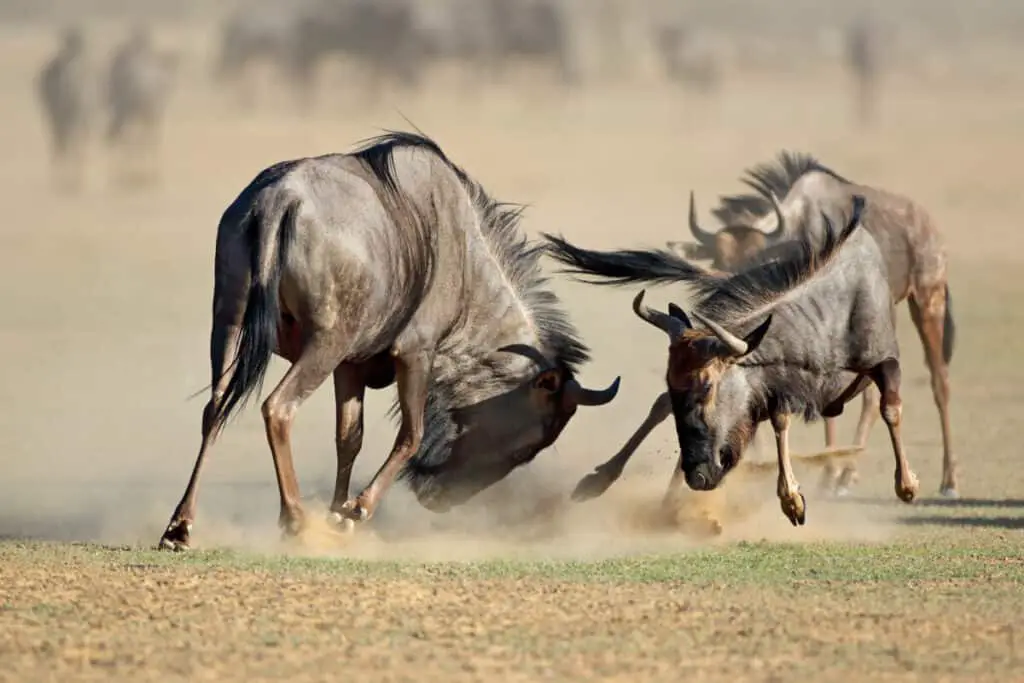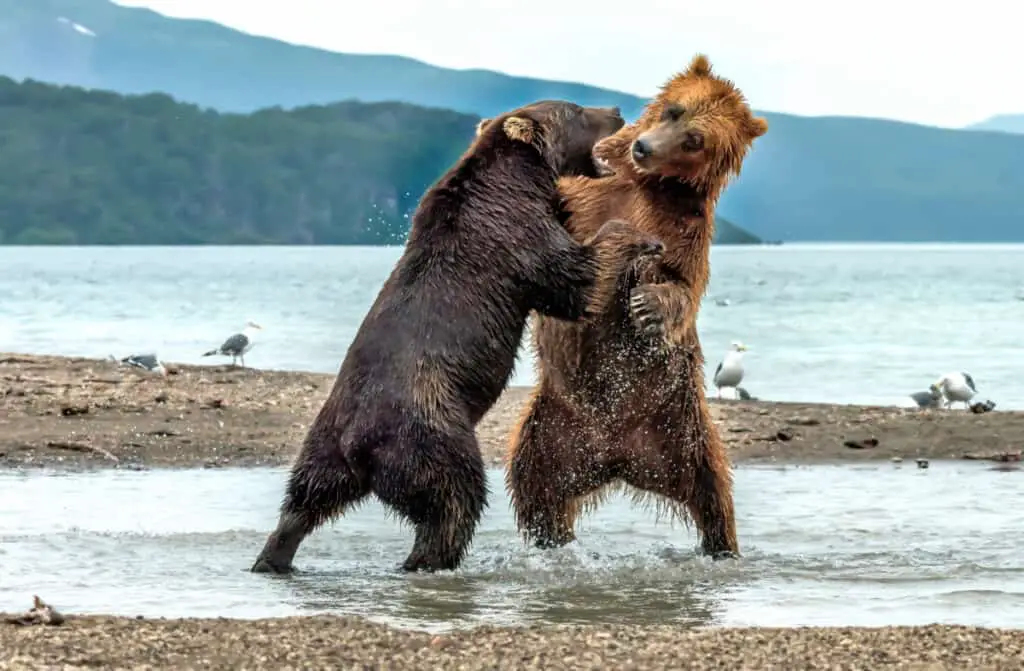Animals engaging in fights is a common occurrence in the animal kingdom, raising questions about the reasons behind these aggressive behaviors. Understanding why animals fight is crucial for comprehending various aspects of their social structures, survival strategies, and interactions with their environment.
This article aims to explore the underlying motives behind animal fights by analyzing factors such as establishing dominance within social groups, defending territory and resources, securing access to food, and ensuring survival in competitive environments.
One significant reason for animals engaging in fights is establishing dominance within social groups. In many species, hierarchical structures exist among individuals where dominant individuals hold higher positions and enjoy certain privileges over subordinate ones. Fights serve as a means to establish this hierarchy by determining which individual possesses greater physical strength or other advantageous traits. Through these confrontations, animals strive to assert their authority and gain control over resources and mating opportunities. By examining how dominance hierarchies are established through fights, we can gain insights into the complex dynamics of animal societies and understand how power structures shape their behavior.
Another motive behind animal fights lies in defending territory and resources. Animals often inhabit specific areas that provide them with essential resources such as food, water, or shelter. These territories are critical for survival and reproductive success; hence conflicts arise when individuals encounter rivals who threaten their access to these limited resources. Fights enable animals to protect their territories by intimidating intruders or driving them away through displays of aggression or physical combat. Understanding these territorial disputes sheds light on the intricate ways animals adapt to their environment and compete for vital resources necessary for sustaining life.
By delving into the reasons why animals engage in fights – be it for establishing dominance within social groups or defending territory and resources – we can gain valuable insights into the complexities of the animal kingdom’s social structures and survival strategies. Exploring how they secure access to food ensures they survive in competitive environments highlights the importance of understanding these aggressive behaviors further. By adopting an academic approach devoid of personal pronouns, this article aims to present an objective analysis of the motives behind animal fights and provide a comprehensive understanding of these intriguing phenomena.

Establishing Dominance within Social Groups
The establishment of dominance within social groups is a fundamental aspect of animal behavior, serving as a mechanism for resource allocation and maintaining order within the group.
Social hierarchy refers to the ranking system that exists among members of a social group, where individuals are organized based on their dominant or submissive status. This hierarchical structure helps to reduce conflict and aggression by providing clear rules and expectations for group interactions.
Aggression patterns play a crucial role in establishing dominance within social groups. Animals use various forms of aggression, such as physical combat or displays of strength, to assert their dominance over others. These aggressive behaviors serve as signals to communicate an individual’s position in the social hierarchy and deter potential challengers.
By engaging in aggressive encounters, animals can establish their rank within the group and secure access to important resources such as food, mates, or territory.
Understanding the dynamics of social hierarchies and aggression patterns provides insight into why animals fight. It allows researchers to study how individuals compete for resources and how these competitions influence group dynamics.
By examining these aspects of animal behavior, scientists can gain a better understanding of the evolutionary significance behind fighting behaviors and its impact on overall species survival.
Maintaining Order and Preventing Power Struggles
To maintain order and prevent power struggles, it is crucial for organisms to engage in various forms of conflict resolution.
Maintaining a social hierarchy is essential within animal groups as it helps to establish clear roles and responsibilities among individuals. This hierarchy ensures that each member knows their place in the group and reduces the likelihood of conflicts arising from misunderstandings or competition for resources. Through dominance displays, such as aggressive posturing or vocalizations, animals communicate their rank within the group and establish a pecking order. This clear structure allows individuals to interact with minimal conflict, as each member understands their position relative to others.
Minimizing conflicts is another important aspect of maintaining order within animal groups. Animals employ various strategies to reduce aggression and resolve disputes before they escalate into full-blown fights. One common method used by many species is ritualistic combat or play fighting. By engaging in mock battles, animals can practice their fighting skills without causing serious harm to one another. These playful interactions also serve as a way for individuals to test each other’s strength and assess potential opponents without risking injury.
Another strategy used by animals to minimize conflicts is through the establishment of territories or individual space boundaries. Defending a territory allows an animal access to essential resources like food, water, or mates while reducing encounters with unfamiliar individuals and potential conflicts that may arise from such interactions. By clearly delineating boundaries and displaying territorial behavior such as marking with scent or vocalizations, animals can communicate ownership and avoid unnecessary confrontations.
Overall, maintaining order and preventing power struggles within animal groups is crucial for ensuring cooperation, minimizing conflicts, and promoting efficient resource allocation. Through establishing social hierarchies, engaging in ritualistic combat or play fighting, and defending territories, animals are able to navigate social interactions while minimizing aggressive encounters. These conflict resolution strategies contribute towards stable group dynamics and enhance overall survival chances for individuals within the group.
Defending Territory and Resources
Defending territory and resources is a crucial behavior exhibited by many organisms to ensure access to essential necessities. Understanding animal behavior in this context requires considering the evolutionary advantages that come with defending territory and resources. By establishing and defending their territories, animals can secure access to vital resources such as food, water, mates, and shelter. This allows them to increase their chances of survival and reproductive success.
One way animals defend their territory is through aggressive displays or physical confrontations with intruders. These displays serve as a warning signal to potential competitors, indicating ownership of the area and deterring them from encroaching. Animals may also use vocalizations or scent markings to mark their territory and communicate its boundaries. For example, male lions roar loudly to establish their presence over a particular area while leaving scent marks on rocks or trees within their territory.
Incorporating a table can help provide a visual representation of different animal species’ behaviors when it comes to defending territory and resources:
| Animal Species | Defending Behavior |
|---|---|
| Lions | Roaring, scent marking |
| Wolves | Howling, territorial aggression |
| Birds | Singing, wing-flapping |
Understanding these different strategies employed by various species helps researchers gain insights into how animals have evolved to protect their territories effectively. In conclusion, defending territory and resources is an essential aspect of animal behavior that provides evolutionary advantages by ensuring access to essential necessities for survival and reproduction.
Securing Access to Food
Securing access to food requires strategic behaviors and adaptations that ensure the survival and reproductive success of organisms.
In the animal kingdom, competition for resources is a common driving force behind conflicts and fights. Animals often engage in aggressive behaviors towards each other in order to gain an advantage when it comes to obtaining food. This competition can be observed within a species or between different species competing for the same resources.
To secure access to food, animals have developed various strategies for obtaining their necessary sustenance. Some animals rely on physical attributes such as strength, speed, or agility to overpower their competitors and monopolize food sources. For example, predators like lions or cheetahs employ hunting techniques that give them an edge over their prey, allowing them to secure a meal.
Other animals may use deception or cunning tactics to outsmart their rivals and gain access to coveted food resources. Certain bird species, like the African honeyguide bird, are known to lead humans or other animals towards beehives in exchange for a share of the honeycomb once it’s been opened.
Securing access to food is crucial for the survival and reproductive success of organisms. The competition for resources drives animals to develop various strategies aimed at obtaining sufficient nutrition. Whether through physical prowess or cunning tactics, animals adapt and evolve in order to gain an advantage over others when it comes to securing their essential sustenance.
Ensuring Survival in Competitive Environments
Survival in competitive environments demands the development of strategic and adaptive behaviors that ensure organisms can overcome challenges and thrive.
In the animal kingdom, competition for resources such as food, mates, and territory is a common occurrence. Animals fight to secure these resources because it provides them with evolutionary advantages that increase their chances of survival and reproduction.
One important reason why animals engage in fights is to establish dominance hierarchies within their social groups. By engaging in aggressive behavior, individuals can gain access to limited resources and assert their dominance over others. This hierarchical structure reduces the need for constant fighting, as lower-ranking individuals will generally yield to higher-ranking ones.
Establishing dominance through fights also serves as a way for animals to communicate signals about their strength and fitness. For example, male animals often engage in physical combat during mating seasons to demonstrate their prowess and win the favor of females.
Furthermore, fights among animals can help resolve conflicts or disputes over territory boundaries or mating rights. By engaging in confrontations, animals are able to defend their territories against intruders or rivals who pose a threat to their survival or reproductive success. These fights allow individuals to stake claim on valuable resources necessary for their well-being and future generations.
Ensuring survival in competitive environments requires animals to develop strategic behaviors that enable them to overcome challenges and secure vital resources. Engaging in fights allows them to establish dominance hierarchies within social groups, communicate signals about strength and fitness, as well as resolve conflicts over territories or mating rights. Through these competitive interactions, animals gain evolutionary advantages that enhance their chances of survival and successful reproduction.

Insights into Social Structures
Insights into social structures can be gained through the study of competitive interactions among organisms in their natural habitats. Animals engage in fights to establish social hierarchies within their groups. These hierarchies determine the distribution of resources such as food, mates, and territory. By observing these interactions, researchers can identify dominant and subordinate individuals, as well as understand how they interact with each other.
Social hierarchies provide stability within animal groups by reducing conflict and ensuring efficient resource allocation. Communication patterns play a crucial role in the establishment and maintenance of social structures among animals. During fights, animals use various forms of communication to convey dominance or submission signals to their opponents. These signals may include aggressive displays such as vocalizations, body postures, or physical aggression. Understanding these communication patterns allows researchers to decipher the complex social dynamics within animal groups.
Studying competitive interactions among animals provides valuable insights into social structures. Through the observation of social hierarchies and communication patterns during fights, researchers can better understand how animals establish dominance and communicate within their groups. This knowledge helps shed light on the intricate workings of animal societies and contributes to our understanding of why animals fight.
Survival Strategies in the Animal Kingdom
In exploring the social structures of animals, it becomes evident that survival is a key driving force behind their interactions. Animals have developed various strategies to ensure their survival in the competitive environment of the animal kingdom.
These strategies often involve engaging in fights or conflicts with other individuals or groups. By understanding these survival strategies and the reasons behind animal fights, we can gain insights into the complex dynamics of their social interactions.
Evolutionary adaptations play a crucial role in shaping an animal’s ability to survive and thrive. Through natural selection, certain traits and behaviors become more prevalent within a population over time. In terms of fighting, animals have evolved specific physical characteristics and behaviors that enhance their chances of survival during conflicts.
For example, some species have developed sharp claws or powerful jaws that allow them to inflict damage on opponents. Others may possess protective armor or thick skin that provides defense against attacks.
Communication signals also play a vital role in determining the outcome of animal fights. These signals serve as a means for animals to convey information about their intentions, strength, and willingness to engage in conflict. Such signals can be visual displays like aggressive postures or coloration patterns, auditory cues such as vocalizations or growls, or even chemical signals released through scent marking.
By interpreting these communication signals correctly, animals are able to assess potential opponents and make strategic decisions regarding whether to fight or retreat.
Overall, understanding the evolutionary adaptations and communication signals involved in animal fights provides valuable insights into how animals navigate the challenges of survival within their social structures. By studying these dynamics, researchers can further our knowledge of the intricate mechanisms underlying animal behavior and contribute to our broader understanding of life on Earth.
